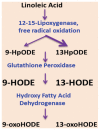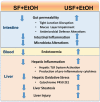Alcoholic Liver Disease: Update on the Role of Dietary Fat
- PMID: 26751488
- PMCID: PMC4808795
- DOI: 10.3390/biom6010001
Alcoholic Liver Disease: Update on the Role of Dietary Fat
Abstract
Alcoholic liver disease (ALD) spans a spectrum of liver pathology, including fatty liver, alcoholic steatohepatitis, and cirrhosis. Accumulating evidence suggests that dietary factors, including dietary fat, as well as alcohol, play critical roles in the pathogenesis of ALD. The protective effects of dietary saturated fat (SF) and deleterious effects of dietary unsaturated fat (USF) on alcohol-induced liver pathology are well recognized and documented in experimental animal models of ALD. Moreover, it has been demonstrated in an epidemiological study of alcoholic cirrhosis that dietary intake of SF was associated with a lower mortality rates, whereas dietary intake of USF was associated with a higher mortality. In addition, oxidized lipids (dietary and in vivo generated) may play a role in liver pathology. The understanding of how dietary fat contributes to the ALD pathogenesis will enhance our knowledge regarding the molecular mechanisms of ALD development and progression, and may result in the development of novel diet-based therapeutic strategies for ALD management. This review explores the relevant scientific literature and provides a current understanding of recent advances regarding the role of dietary lipids in ALD pathogenesis.
Keywords: alcoholic liver disease; gut microbiota; oxidized dietary lipids; oxidized linoleic acid metabolites; saturated and unsaturated dietary fat.
Figures




Similar articles
-
Saturated and Unsaturated Dietary Fats Differentially Modulate Ethanol-Induced Changes in Gut Microbiome and Metabolome in a Mouse Model of Alcoholic Liver Disease.Am J Pathol. 2016 Apr;186(4):765-76. doi: 10.1016/j.ajpath.2015.11.017. Am J Pathol. 2016. PMID: 27012191 Free PMC article.
-
The type of dietary fat modulates intestinal tight junction integrity, gut permeability, and hepatic toll-like receptor expression in a mouse model of alcoholic liver disease.Alcohol Clin Exp Res. 2012 May;36(5):835-46. doi: 10.1111/j.1530-0277.2011.01673.x. Epub 2011 Dec 7. Alcohol Clin Exp Res. 2012. PMID: 22150547 Free PMC article.
-
Flaxseed oil ameliorates alcoholic liver disease via anti-inflammation and modulating gut microbiota in mice.Lipids Health Dis. 2017 Feb 22;16(1):44. doi: 10.1186/s12944-017-0431-8. Lipids Health Dis. 2017. PMID: 28228158 Free PMC article.
-
Alcoholic liver disease: the gut microbiome and liver cross talk.Alcohol Clin Exp Res. 2015 May;39(5):763-75. doi: 10.1111/acer.12704. Alcohol Clin Exp Res. 2015. PMID: 25872593 Free PMC article. Review.
-
Intragastric ethanol infusion model for cellular and molecular studies of alcoholic liver disease.J Biomed Sci. 2001 Jan-Feb;8(1):20-7. doi: 10.1007/BF02255967. J Biomed Sci. 2001. PMID: 11173972 Review.
Cited by
-
Aging aggravates alcoholic liver injury and fibrosis in mice by downregulating sirtuin 1 expression.J Hepatol. 2017 Mar;66(3):601-609. doi: 10.1016/j.jhep.2016.11.004. Epub 2016 Nov 18. J Hepatol. 2017. PMID: 27871879 Free PMC article.
-
Diet modifies the association between alcohol consumption and severe alcohol-related liver disease incidence.Nat Commun. 2024 Aug 11;15(1):6880. doi: 10.1038/s41467-024-51314-9. Nat Commun. 2024. PMID: 39128919 Free PMC article.
-
Chronic high-dosage fish oil exacerbates gut-liver axis injury in alcoholic steatohepatitis in mice: the roles of endotoxin and IL-4 in Kupffer cell polarization imbalance.Toxicol Res (Camb). 2017 Jul 7;6(5):611-620. doi: 10.1039/c7tx00037e. eCollection 2017 Sep 1. Toxicol Res (Camb). 2017. PMID: 30090529 Free PMC article.
-
High-fat diet promotes multiple binges-induced liver injury via promoting hepatic macrophage proinflammatory polarization.Toxicol Res (Camb). 2023 May 15;12(3):480-492. doi: 10.1093/toxres/tfad033. eCollection 2023 Jun. Toxicol Res (Camb). 2023. PMID: 37397912 Free PMC article.
-
Alcohol Metabolizing Enzymes, Microsomal Ethanol Oxidizing System, Cytochrome P450 2E1, Catalase, and Aldehyde Dehydrogenase in Alcohol-Associated Liver Disease.Biomedicines. 2020 Mar 4;8(3):50. doi: 10.3390/biomedicines8030050. Biomedicines. 2020. PMID: 32143280 Free PMC article. Review.
References
-
- Kirpich I.A., Feng W., Wang Y., Liu Y., Barker D.F., Barve S.S., McClain C.J. The type of dietary fat modulates intestinal tight junction integrity, gut permeability, and hepatic toll-like receptor expression in a mouse model of alcoholic liver disease. Alcohol. Clin. Exp. Res. 2012;36:835–846. doi: 10.1111/j.1530-0277.2011.01673.x. - DOI - PMC - PubMed
Publication types
MeSH terms
Substances
Grants and funding
- U01 AA021893/AA/NIAAA NIH HHS/United States
- U01 AA021901/AA/NIAAA NIH HHS/United States
- P20 GM113226/GM/NIGMS NIH HHS/United States
- P50 AA024337/AA/NIAAA NIH HHS/United States
- R21 AA020849-01A1/AA/NIAAA NIH HHS/United States
- K23AA18399/AA/NIAAA NIH HHS/United States
- R01 AA018869/AA/NIAAA NIH HHS/United States
- 1U01AA021901-01/AA/NIAAA NIH HHS/United States
- 1U01AA021893-01/AA/NIAAA NIH HHS/United States
- R21 AA020849/AA/NIAAA NIH HHS/United States
- R01 ES021375/ES/NIEHS NIH HHS/United States
- K23 AA018399/AA/NIAAA NIH HHS/United States
- AA023681/AA/NIAAA NIH HHS/United States
- R01 AA023681/AA/NIAAA NIH HHS/United States
- 1UO1AA022489/AA/NIAAA NIH HHS/United States
- U01 AA022489/AA/NIAAA NIH HHS/United States
- I01 BX000350/BX/BLRD VA/United States
- R01ES021375/ES/NIEHS NIH HHS/United States
LinkOut - more resources
Full Text Sources
Other Literature Sources
Medical

